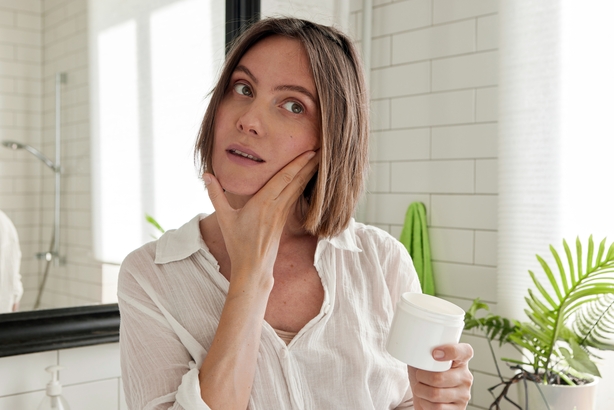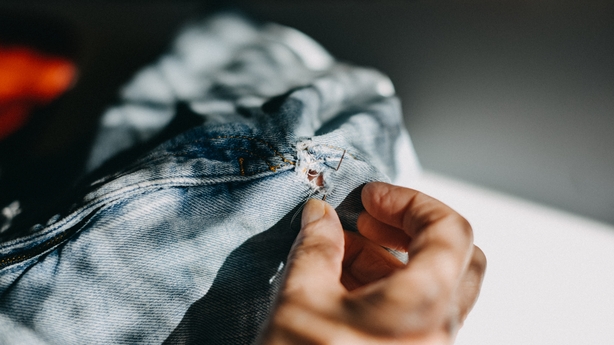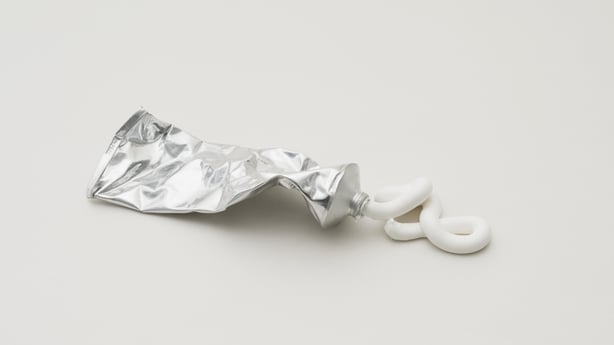Sarah Magliocco writes about why showcasing how little you buy is fast becoming a dominant trend on social media.
"So, what shoes are we wearing this Autumn? I want to know what we're all buying so I can buy them now before they sell out."
It’s a throwaway remark from an influencer, the kind you’ll see a dozen times in a day on a casual scroll through TikTok.
While a drive to get traction on her comments section, it’s also an acknowledgement that trends have evolved, moving beyond a specific hemline or a silhouette, and now focused on singular items - a Stanley brand water bottle, Adidas Sambas, Damson Madder leopard print jeans.
These spotlighted items change week to week depending on the whims of the TikTok hivemind, creating an exhausting and often exclusionary online environment.
Amidst this landscape, however, there has been a shift, and a new trend is emerging where normal consumption is being lauded.
'Under-consumptioncore' is the newest ironic TikTok neologism that is fast garnering a fan base. Rather than being centred around owning specific items, like 'Barbiecore' and its pink aesthetic or 'normcore' and its understated basics, underconsuptioncore celebrates the use of our current items to the bitter end.
It's a reversal of the current social media environment where influencers push us to buy endless reams of products, and assign values to items that go beyond class or culture.
Owning an extensive gua-sha focused skincare routine and beige linen bed sheets means you’re in the 'Clean Girl’ tribe; Sol de Janerio body spray and a White Fox brand hoodie mean you’re ‘Preppy’ (and probably a teenager); and a gingham dress and silk scarf in your hair, well you’re probably a well-travelled ‘Tomato Girl’.
These aesthetics are beautifully curated, but ultimately are discarded after months or even mere weeks, leaving a trail of barely used fashion, beauty and lifestyle purchases in their wake as people clamour to move on to the next chic movement.

Given the reactionary nature of social media, it's not surprising that under-consumptioncore has emerged as a salve to this. Makeup and beauty videos on TikTok most obviously show the difference. Traditionally, videos of people laden with shopping bags and filming 'hauls’ of their newly bought makeup products have been exceptionally popular, alongside tours of people’s huge collections of makeup, skincare and hygiene items.
However, sustainability activists and the generally sensible have long pointed out that it is wasteful to hoard endless shelves, drawers and baskets of makeup or skincare, as these products have an expiry date and often cannot be passed on to others due to hygiene reasons.
In contrast, under-consumptioncore videos show almost empty concealer tubes with their branding faded by time, eyeshadow palettes where all of the shades are dented, their shiny pans glinting through, and foundation tubes cut in half with the kitchen scissors to access every last drop. Other videos show well-darned socks, chipped crockery, repaired or altered decades-old clothing and restored furniture as examples.
The trend makes a point that using and appreciating what you already have can be just as fulfilling as the buzz of buying, and has something of a moral halo effect too, as you know you’re not adding to further harm to the planet by over consuming.

While this may sound like just being normal and using products in a sensible way to the vast majority of people, amid the pressure to buy into the latest trends, using up products properly has been revolutionary.
It has rarely been shown outside of low-waste and sustainability circles, so finding a place on the for you page of millions is quite a feat.
Upcycling, repairing and well-using are not new concepts by any stretch of the imagination, but now they are being neatly packaged into a trend that literally anyone can join in on. It's a rebrand of conscious consumption for the TikTok brigade.
With shopping hauls and videos ushering in the era of a new it-item, there is a certain amount of spending power behind them. For young people and those with limited means, especially in a cost of living crisis, showing off what they don’t buy and how much use they get out of old items can be an invigorating change, even if it is a normal part of their day-to-day and has been for generations.

For many it is simply a reaction to the feeling that we are always being sold something. Between TikTok Shop, where people can buy directly through the app, and algorithms that seem to read our minds and shove the opportunity to shop directly onto our social media feeds, there is an air of fatigue.
Choosing to buy less or slow down our consumption is a powerful decision, especially on social media where platforms sell our attention to advertisers. The under-consumptioncore mindset frames purchasing through an ecological lens, reminding people to consider the limitations of our planet when we mindlessly shop.
For long-term advocates of sustainability, the trend might be an excellent recruiter, introducing an awareness of hyperconsumption to those who may not realise they take part in it. However, the trend is not going to have any longevity if we don’t go deeper than that, and demand that the products that we do buy are made ethically and are something worth passing down to new generations.
While under-consumptioncore might be trending online, a battle cry of the weary taking their power back from influencers, algorithms and their overlords, it will be lost to the trend cycle as easily as skinny jeans unless real change is actioned in its name.
The views expressed here are those of the author and do not represent or reflect the views of RTÉ.


